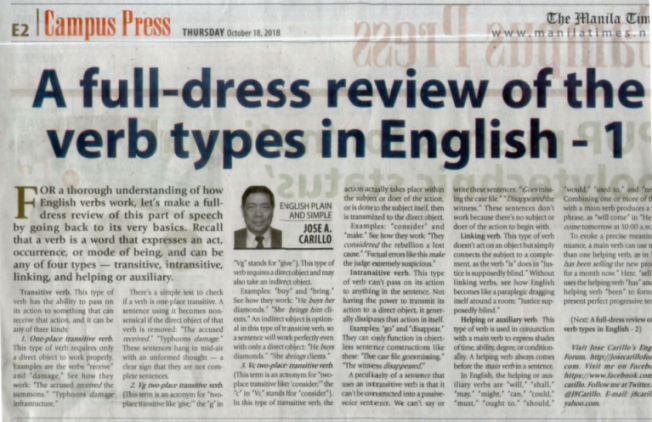For a thorough understanding of how English verbs work, let’s make a full-dress review of this part of speech by going back to its very basics. Recall that a verb is a word that expresses an act, occurrence, or mode of being, and can be any of four types—
transitive,
intransitive,
linking, and
helping or auxiliary.
(Some grammarians classify English verbs into three types:
action verbs subsuming transitive and intransitive verbs,
linking verbs, and
helping or auxiliary verbs. Depending on how they are used, however, some linking verbs can function as action verbs, as we will find out in the course of this full-dress review of the English verbs.)
Transitive verb. This type of verb has the ability to pass on its action to something that can receive that action, and it can be any of three kinds:
IMAGE CREDIT: WOODWARD ENGLISH1. One-place transitive verb. This type of verb requires only a direct object to work properly. Examples are the verbs “receive” and “damage.” See how they work: “The accused
received the summons.” “Typhoons
damage infrastructure.”
There’s a simple test to check if a verb is one-place transitive. A sentence using it becomes nonsensical if the direct object of that verb is removed: “The accused
received.” “Typhoons damage.” One-place transitive sentences without a direct object hang in mid-air with an unformed thought—a clear sign that they are not complete sentences.
2. Vg two-place transitive verb. (This term is an acronym for “two-place transitive like ‘give’”; the “g” in “Vg” stands for “give”). This type of verb requires a direct object and may also take an indirect object.
Examples: “buy” and “bring.” See how they work: “He
buys her diamonds.” “She
brings him clients.” An indirect object is optional in this type of transitive verb, so a sentence will work perfectly even with only a direct object: “He
buys diamonds.” “She
brings clients.”
3. Vc two-place transitive verb. (This term is an acronym for “two-place transitive like ‘consider’”; the “c” in “Vc” stands for “consider”). In this type of transitive verb, the action actually takes place within the subject or doer of the action, or is done to the subject itself, then is transmitted to the direct object.
Examples: “consider” and “make.” See how they work: “They
considered the rebellion a lost cause.” “Factual errors like this
make the judge extremely suspicious.”
Intransitive verb. This type of verb can’t pass on its action to anything in the sentence. Not having the power to transmit its action to a direct object, it generally dissipates that action in itself.
IMAGE CREDIT: SLIDESHARE.COMExamples: “go” and “disappear.” They can only function in objectless sentence constructions like these: “The case file
goes missing.” “The witness
disappeared.”
A peculiarity of a sentence that uses an intransitive verb is that it can’t be constructed into a passive-voice sentence. We can’t say or write these sentences: “
Goes missing the case file.” “
Disappeared the witness.” These sentences don’t work because there’s no subject or doer of the action to begin with.
Linking verb. This type of verb doesn’t act on an object but simply connects the subject to a complement, as the verb “is” does in “Justice
is supposedly blind.” Without linking verbs, see how English becomes like a paraplegic dragging itself around a room: “Justice supposedly blind.”
IMAGE CREDIT: SLIDEPLAYER.COMHelping or auxiliary verb. This type of verb is used in conjunction with a main verb to express shades of time, ability, degree, or conditionality. A helping verb always comes before the main verb in a sentence.
In English, the helping or auxiliary verbs are “will,” “shall,” “may,” “might,” “can,” “could,” “must,” “ought to,” “should,” “would,” “used to,” and “need.” Combining one or more of them with a main verb produces a verb phrase, as “will come” in “He
will come tomorrow at 10:00 a.m.”
IMAGE CREDIT: ENGLISHSTUDYHERE.COMTo evoke a precise meaning or nuance, a main verb can use more than one helping verb, as in “She
has been selling the new product for a month now.” Here, “selling” uses the helping verb “has” and the helping verb “been” to form the present perfect progressive tense.
 This essay, 1,114th of the series, appeared in the column “English Plain and Simple” by Jose A. Carillo in the Campus Press section of the October 18, 2018 issue (print edition only) of
This essay, 1,114th of the series, appeared in the column “English Plain and Simple” by Jose A. Carillo in the Campus Press section of the October 18, 2018 issue (print edition only) of The Manila Times
, © 2018 by the Manila Times Publishing Corp. All rights reserved.(Next:
A full-dress review of the verb types in English - 2) October 25, 2018
PARTS 2, 3, 4, 5, 6, AND 7 (OCTOBER 18, 2019 RETROSPECTIVE):A full-dress review of the verb types in English - 2A full-dress review of the verb types in English - 3A full-dress review of the verb types in English - 4A full-dress review of the kinds of verbs in English – 5A full-dress review of the kinds of verbs in English – 6A full-dress review of the kinds of verbs in English – 7